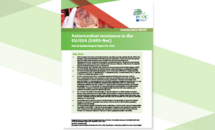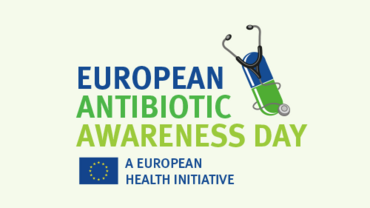Antimicrobial resistance in the EU/EEA (EARS-Net) - Annual Epidemiological Report for 2019
This report is based on data reported to the European Antimicrobial Resistance Surveillance Network (EARS-Net) for the period 2015 to 2019, retrieved from The European Surveillance System (TESSy) and ECDC’s decentralised data storage for antimicrobial resistance and healthcare-associated infections (ARHAI) on 10 September 2020.
Executive summary
Key facts
- Thirty European Union (EU) or European Economic Area (EEA) countries reported data for 2019 to the European Antimicrobial Resistance Surveillance Network (EARS-Net). Twenty-nine countries reported data for all eight bacterial species under surveillance by EARS-Net (Escherichia coli, Klebsiella pneumoniae, Pseudomonas aeruginosa, Acinetobacter species, Streptococcus pneumoniae, Staphylococcus aureus, Enterococcus faecalis and Enterococcus faecium), while one country reported data for all bacterial species except S. pneumoniae.
- EARS-Net data for 2019 displayed wide variations in the occurrence of antimicrobial resistance (AMR) across the EU/EEA depending on the bacterial species, antimicrobial group and geographical region.
- The most commonly reported bacterial species was E. coli (44.2%), followed by S. aureus (20.6%), K. pneumoniae (11.3%), E. faecalis (6.8%), P. aeruginosa (5.6%), S. pneumoniae (5.3%), E. faecium (4.5%) and Acinetobacter species (1.7%).
- In 2019, more than half of the E. coli isolates reported to EARS-Net and more than a third of the K. pneumoniae isolates were resistant to at least one antimicrobial group under surveillance, and combined resistance to several antimicrobial groups was frequent. Resistance percentages were generally higher in K. pneumoniae than in E. coli. While carbapenem resistance remained rare in E. coli, several countries reported carbapenem resistance percentages above 10% in K. pneumoniae. Carbapenem resistance was also common in P. aeruginosa and Acinetobacter species, and at higher percentages than in K. pneumoniae. For most gram-negative bacterial species–antimicrobial group combinations, changes in resistance percentages between 2015 and 2019 were moderate, and resistance remained at previously reported high levels.
- For S. aureus, the decline in the percentage of meticillin-resistant (i.e. MRSA) isolates reported in previous years continued in 2019. Nevertheless, MRSA remains an important pathogen in the EU/EEA, with levels still high in several countries, and combined resistance to another antimicrobial group was common. Decreases during the same period were also noted for penicillin non-wild type and macrolide resistance in S. pneumoniae.
- One development of particular concern was the increase in the percentage of vancomycin-resistant isolates of E. faecium in the EU/EEA, from 10.5% in 2015 to 18.3% in 2019 (EU/EEA population-weighted mean percentage).
- For several bacterial species–antimicrobial group combinations, a north-to-south and west-to-east gradient was evident in the EU/EEA. In general, lower percentages of resistance were reported by countries in the north of Europe and higher percentages were reported by countries in the south and east of Europe. However, for vancomycin-resistant E. faecium, no distinct geographical pattern was evident.
Download

Country summaries - antimicrobial resistance in the EU/EEA 2019 - EN - [PDF-28.44 MB]
Additional tables - antimicrobial resistance in the EU/EEA 2019 - EN - [PDF-2.98 MB]






